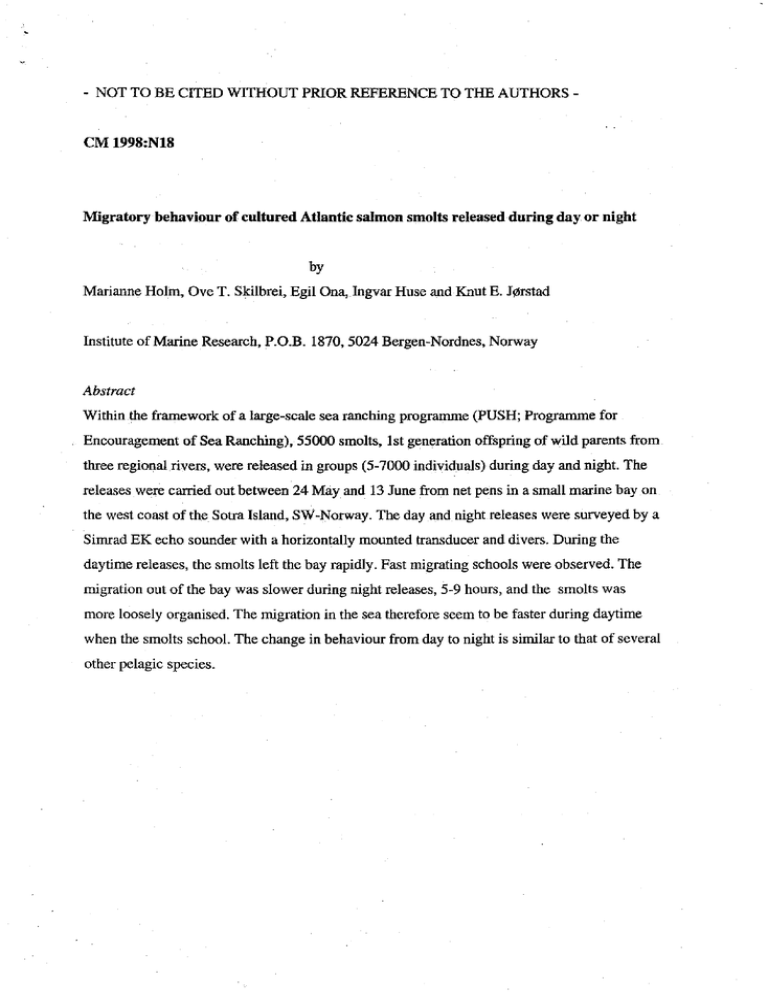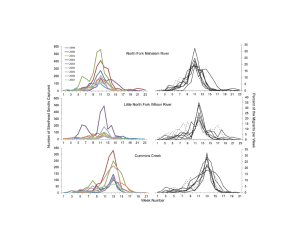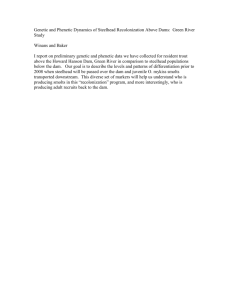Migratory behaviour of cultured Atlantic salmon smolts released during day...
advertisement

- NOT TO BE CITED WITHOUT PRIOR REFERENCE TO THE AUTHORS -
CM1998:N18
Migratory behaviour of cultured Atlantic salmon smolts released during day or night
by
Marianne Holm, Ove T. Skilbrei, Egil Ona, Ingvar Huse and Knut E. Jl1lrstad
Institute of Marine Research, P.O.B. 1870, 5024 Bergen-Nordnes, Norway
Abstract
Within the framework of a large-scale sea ranching programme (PUSH; Programme for
Encouragement of Sea Ranching), 55000 smolts, 1st generation offspring of wild parents from
three regional rivers, were released in groups (5-7000 individuals) during day and night. The
releases were carried out between 24 May and 13 June from net pens in a small marine bay on
the west coast of the Sotra Island, SW-Norway. The day and night releases were surveyed by a
Sirnrad EK echo sounder with a horizontally mounted transducer and divers. During the
daytime releases, the smolts left the bay rapidly. Fast migrating schools were observed. The
migration out of the bay was slower during night releases, 5-9 hours, and the smolts was
more loosely organised. The migration in the sea therefore seem to be faster during daytime
when the smolts school. The change in behaviour from day to night is similar to that of several
other pelagic species.
Introduction
Atlantic salmon has developed a variety of behavioural adaptations enabling it to adapt to both
the freshwater and the open sea environment. In the river, there are relatively few other
species, and intra specific competition for the resources (Symons 1971). When leaving the
river, there is a change from individual aggressive behaviour to schooling behaviour (Gibson,
1983, Bakshtanskiy et al. 1988). The transition from a fresh- to a seawater adapted fish has
encouraged a large scientific effort, especially concerning the physiological smoltification
process of cultured salmon. While the osmotic adjustments during seawater transfer has been
described in a high number of papers, our knowledge on the change in behaviour after
seawater entry of wild and released smolts is less known.
In release experiments, monitoring of the behaviour of the smolts in the release area may be
important for evaluation and improvement of the release methods (Skilbreiet al.1994a,b).
Such studies are difficult to perform, because of the large water volumes to be surveyed.
Hydroacoustic tagging may be use to follow single fish, but then information on the behaviour
of groups of fishes will be lacking. This study reports an attempt to study the post-release
behaviour of smolts in the sea by applying echo sounder technique. The fish were released
during day- or night time to see whether the migratory behaviour changed during the day night cycle.
Materials and Methods
The fish released in the experiments were 1+ smolts descending from wild parents caught in
the regional rivers Vosso, Loneelv and Dale. During late winter 1990 yolk sac fry were
transferred to the Selst¢ hatchery in the immediate vicinity of the release area. In addition, fry
from a cultured strain were included. The fish were raised according to standard fish farming
practices. However, due to genetic considerations, the family groups were kept separated in I
x 1 m tanks until the fish were large enough to be adipose fin-clipped. Then groups were
united two and two and transferred to outdoor cylindrical 5-7 m diameter tanks.
2
In April - May three release groups were set up by mixing the offspring of the different
groups, and a fourth group consisted of the cultured strain. At various dates, the fish
w~re
transferred to and released from net pens in the Selsti1l Bay (see Table 1 for details). The Selsti1l
Bay is located close to open sea at the western coast of Norway (Fig. 1). The salinity at 0.1 m
depth was around 32 %0. The fish were released at or just before high tide.
60.25"N
Figure 1. Location of the Selsti1l Bay in western Norway.
The tidal forces in the area are relatively weak; with a maximum difference of between low
and high tide of approximately 0.9 m. Due to a of combination of the Norwegian coastal
current pressing the water inwards in the small fjords, the prevailing winds and the tidal
forces, the predominant current pattern in the Selsti1l bay was an ingoing surface current on the
south side and an outgoing surface current on the north side. The sea temperature at 1 m depth
was 8.20 C during the first releases (24 - 28 May), rising to 11 0 C during the last release (14
June).
3
Fig 2. Location of the boat equipped with the EK-500 echo sounder and of the net pens in the
Selstlii Bay. The hatchery is indicated to the right in the figure.
Table 1: Dates for transfer to net pens in the sea, dates and time for releases and number and
origin of fish where W=offspring from wild and C=offspring from cultured parents.
Origin
Number
22:45
W
8000
27.05
10:00
W
8000
27.05
28.05
10:00
W
5000
07.06
14.06
24:10
C
10000
Release
Transfer
Release
Release
group
date
date
time
1
15.05
24.05
2
16.05
3
4
During the releases, the fish behaviour in the inner part of the bay, and in the vicinity of the
net pens, was observed by divers with underwater video-equipment. Further out in the bay, the
fish were acoustically observed from a boat! anchored close to the southern side of the bay.
The boat was equiped with an EK-500 split beam echo sounder connected to a 120 kHz
4
transducer on the bow of the boat (Fig. 2). The acoustic beam was oriented horizontally along
the surface across the bay with an opening of 10°.
Using a ping rate of about 4
S·l,
the individual smolts passing the beam could be detected
repeatedly at moderate swimming speeds. The echo trace data telegrams of the split beam
echo sounder were logged over serial line to a portable PC and Target Tracking software (Ona
& Hansen 1991). Individual tracks were counted in time blocks from the echogram output and
the approximate size of schools passing were estimated from the integrator output on schools
and individual fish.
Results
The divers reported that the fish left the net pens rapidly after release, but the migration out of
the bay was substantial faster when the smolts were released during daytime. After the
daytime releases (release time 10:00 and 11 :00) must of the smolts passing the echo beam
were registered during the first hour after release (Fig. 3 and 4). However, on May 28, there is
a delay of several hours before the last part of the smolts passed the echo transducer. This may
be due to a gasoline generator placed on a raft between the EK500 monitoring point and the
net pens. The generator was erroneously switched on to power video equipment during this
release. When it was turned off, the fish started to pass the echo beam.
NUMBERS
160
r-----------------------....,
140
120
100
80 .
release
60
40
20
o L - . L - L - L_ _......,......._
0900 0920
0910 0930
0950
1010
1040 1100 1120 1140 1200
1030 1050 1110 1130 1150
TIME
Figure 3. Number of smolts passing the echo beam during day-time release on May 27.
5
NUMBERS
80r---------------------------~------__,
60
40
009000940' ,
, .' ,ltl!IF1320
Tll\(ti{
'Alin1,<JiAC"io:,itI
Figure 4. Number of smolts passing the echo beam during day-time release on May 28.
Figure 5. Number of smolts passing the echo beam during night-time release on May 24.
6
Figure 6. Number of smolts passing the echo beam during night-time release on June 14
After the night releases, fish were crossing the beam of the echo transducer for 4-8 h after
releases, and were roughly evenly distributed with time during these periods (Fig. 5 and 6).
The smolts migrating rapidly out of the during daytime were frequently observed in small,
dense schools. An example is shown in Figure 7, showing a school of approximately 102
individuals on May 27 at 10:35, i.e. within a half our after release. For comparison, detection
of approximately 30 individuals on May 25, at 01.56; three hours after release, show that these
fish were more loosely organised, and that each individual used a longer time to pass the echo
beam making the overall picture more noisy (Fig. 8). However, some schools were observed
after night releases. Within the first 10 min after the release on June 14, three distinct schools
of approx. 20 individuals each were spotted (Fig. 9). Individual fish swimming more slowly,
and therefore targeted by a greater number of pings typical of the night releases, are also
visible on the echo diagram as longer strings (Fig. 9).
7
Fig. 7. Echogram showing the passing of a school of calculated to 102 individuals swimming
of approx. 3 body lengths S·1
8
Fig. 8. A group of 30 individuals passing the echo beam at appr. 1 body length s·' after nighttime release on May 25 01 :55.
9
Fig 9. Fish passing the echo beam within the first 10 minutes after the night-time release on
June 14. Three schools containing approx. 60 in sum is seen in the upper part of the figure. In
addition, there are 9 individual tracks.
Discussion
Due to the small angle of the echo beam only a small part of the smolts were detected when
passing the beam. It is therefore uncertain if these fish are representative for the different
release groups. However, the demonstration of the basic behavioural patterns, to swim rapidly
in a school or to prolong the stay in the release area in less organised shoals or as individuals
spread over an area, probably reflect a change in behaviour during the day and night cycle.
During the two consecutive years all smolts were released from the net pens during daytime.
The clear tendency of the smolls to leave the bay within a short time interval and also the
formation of rapidly migrating schools were observed repeatedly, although smolt size and the
10
date of release also influenced the migration motivation (Skilbrei et al., 1994a,b). In the
present study the acclimatisation period differed between the releases. The duration of .
acclimatisation period had a relatively small influence on the migratory behaviour in the
consecutive years,at least when 3 and 7 days were compared (Skilbrei et al. 1994b). A change
in behaviour from day to night was also observed by Holm et al (1984) in a study tracking
ultrasonic tagged cultured smolts. The migrating smolt stayed closer to surface during night
hours, and the repeated diving activity seen during daytime was reduced or absent during dark
hours.
Assuming that the present results show a general trend of seaward migrating smolts to change
behaviour according to the day/night cycle, then possible explanations may be related to
feeding, migratory behaviour and/or prey-predator interactions. Prey-predator interactions are
strongly influenced by light intensity (Hobson 1978). Several marine species stay close to the
surface during night, and decrease the risk of predation during daytime by moving to greater
depth and/or by schooling (Tricas 1979). Fish in groups generally spend more time to search
for and consume prey and use less time for to recognise and escape predators than single
individuals (Pitcher 1986).
In the release area, most predated smolts have been found in the stomachs of pollack (P.
pollachius) (unpublished data). Fish predators are surely a danger for the smolts in the marine
environment, and additionally, avian predation has been demonstrated for salmon smolts
(Reitan et al. 1987, Kennedy and Greer 1988). The seagulls are active during daytime and may
represent a serious threat for fish staying close to surface. As it is assumed that salmon
migrate in the upper water column (Holm et al. 1982; 1984), the change in behaviour between
day and night may also reflect adaptations to minimise the total predatory risk from both fish
and avian predators. According to Litvak (1993) shoaling fish may change school structure
due to avian attacks.
The schooling behaviour and increased migration speed during daytime may also be a
functional aspect of orientation and migration of salmonids. According to Dodson (1988)
salmon may use sun compass during migration, and schooling is commonly observed for long
distance migrators (Ovchinnikov 1986). Recapture rates have been increased by releasing
smolts into shoals of wild smolts (Hvidsten et al. 1993). The distance from Norwegian salmon
11
rivers to the ocean feeding areas (in the northern Norwegian Sea) may be 2000 kilometres.
The migratory, antipredator and feeding behaviour ofthe young salmon must necessarily be a
result of evolutionary mechanisms enabling fish survival .. The present study does not explain
the mechanisms for the observed changes in behaviour from day to night, but points to·
similarities between our results and general behaviour of marine species. Although the study
was performed with cultured smolts, the differential response of the smolts to the new
environment according to the time of the day probably indicate an inherent adaptability of
salmon when migrating from a freshwater ecosystem into open sea. The use of EK-500 with a
horizontally mounted transducer proved to be a valuable aid to monitor undisturbed migratory
behaviour of groups of smolts. Although the volume covered in this study with only one
single transaucer was relatively limited, it would be possible to cover a substantially larger
area by using several transducers or a scanner.
REFERENCES
Bakshtanskiy, E. L.,Nesterov, V. S. og Neklyudov, M. N. 1988. Development of schooling
behaviour in juvenile Atlantic. salmon, Salrna salar, during seaward migration. J.
Ichthyol. 28: 91-101.
Dodson, J. J. 1988. The nature and role of learning in the orientation and migratory behaviour of
fishes. Envir. BioI. Fish. 23: 161-182.
Gibson,R. J. 1983. Water velocity as a factor in the change from aggressive to schooling
behaviour and subsequent migration of Atlantic salmon smolts (Salrna salar). Nat. Can.
110: 143-148.
Hobson, E. S. 1978. Interactions between piscivorous fishes and their prey. I: Clepper, H. (red.)
1979, Predator prey systems in fisheries management: 231-242.
Holm, M., Huse, L, Waatevik, E., D¢ving, K. B. og Aure, 1. 1982. Behaviour of Atlantic salmon
smolts during migration .. 1: Preliminary report on ultrasonic tracking in a Norwegian
fjord system. ICES CM. M:7: 17 p
Holm, M., Huse, I, Waatevik, E., Aure, 1, & D¢ving, K. 1984. F¢lging av utvandrende
laksesmolt. I: Atferd hos marine dyr (eds: Holm, M, Fern¢e, A & Waldemarsen W.). (In
Norwegian) Foredrag fra symposium, as, 9-10 februar 1983: 8-14
12
Hvidsten, N. A. og Jonsson, B. 1993. Increased recapture rate of adult Atlantic salmon released
as smolts into large shoals of wild smolts in the river Orkla, Norway. N. Am. J. Fish.
Manage. 13: 272.276.
Kennedy, G. J. A. og Greer, J. E. 1988. Predation by connorants, Phalacrocorax carbo (L.), on
the salmonid populations of an Irish river. Aquacult. Fish. Manage. 19: 159-170.
Litvak:, M. K. 1993. Response of shoaling fish to the threat of aerial predation. Environ. BioI.
Fish. 36: 183-192.
Ovchinnikov, V. V. 1986. Migration behaviour and distant migrations of fish. I: Sauskan, V. I.
(red.) 1986, Life-cycles, distribution and migrations of commercial fishes from the
Atlantic and Pacific oceans. 37-47.
Pither, T. J. 1986. Functions of shoaling behaviour in teleosts. I: Pitcher, T. J. (red.), The
behaviour of teleost fishes. 294-337.
Reitan, 0., Hvidsten, N. A. og Hansen, L. P. 1987. Bird predation on hatchery reared Atlantic
salmon smolts, Salrno salar L., released in the river Eira, Norway. Fauna Norv. 8: 38-38.
Skilbrei, O. T., JlIlrstad, K. E., Holm, M., Farestveit, E., Grimnes, A. og Aardal, L. 1994a. A new
release method for coastal ranching of Atlantic salmon (Salrno salar) and behavioural
patterns ofreleased smolts. Nordic J. Freshw. Res.: X-X
Skilbrei, O. T., Holm, M., JlIlrstad, K. E. og Handeland, S. O. 1994b. Migration motivation of
cultured Atlantic salmon, Salrno salar L., smolts in relation to size, time of release and
acclimatization period. Aquacult. Fish. Manage. 25: 65-78.
Symons, P. E. K. 1971. Behavioural adjustment of population density to available food by
juvenile Atlantic salmon. J. Anim. Ecol. 40: 569-587.
Tricas, T. C. 1979. Relationships of the blue shark, Prionace glauca, and its prey species near
Santa Catalina Island, California. Fish. Bull. 77: 175-182.
13




